Article and all photos by Joe Mock, BaseballParks.com
All rights reserved
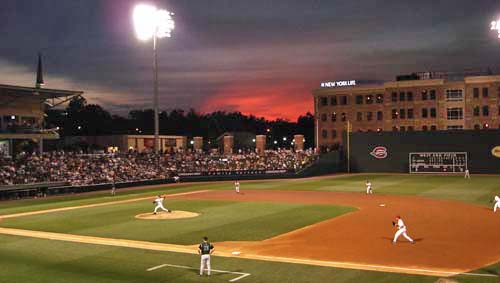 |
If you wanted to experience what a game at Fenway Park is like, where would you go? Why, South Carolina, of course!
| Ballpark Stats |
 |
| Team: Greenville Drive of the Class A South Atlantic League |
| First game: April 6, 2006, a 6-1 win over Columbus |
| Capacity: 6,400, including 5,700 actual seats |
| Architect: DLR |
| Price: The privately financed construction cost $18 million |
| Home dugout: 1B side |
| Field points: North by northeast |
| Playing surface: grass |
| Betcha didn’t know: 500,000 of the bricks used to construct the park were reclaimed from demolished mills in the area |
To be precise, you’d head to the charming city of Greenville, where their previous Minor League ballpark was anything but charming. That park, Greenville Municipal Stadium, wasn’t actually in Greenville. It was in a suburb on the south side of town called Mauldin.
The reason Greenville has a brand-new park has a lot to do with Municipal Stadium, which is still standing down on Mauldin Road. It was the long-time home of the Greenville Braves, members of the Double-A Southern League. As a facility at this level, it was certainly not up to snuff, and the big Braves, which own their Double-A affiliate, were not shy about saying so. Things came to an impasse in the fall of 2003, when the Braves told the city that if they didn’t come up with a plan for a new ballpark that met their criteria and budget, they were hitting the road. And that’s exactly what they did following the 2004 season, when they moved the team into the newly built Trustmark Park in Pearl, Mississippi.
Since Greenville was pretty far along with plans for a new stadium in the western end of their downtown, the market became a hot commodity, with no fewer than three Minor League franchises vying to move there — although two were eyeing the suburbs instead of Greenville’s West End for their new park. The winners of the beauty contest, thankfully, were the Capital City Bombers, the South Atlantic League (Low A) entry in Columbia, South Carolina. They were thrilled to pursue a new stadium within Greenville’s city limits, and not out in the ‘burbs. The Bomber’ stadium in Columbia was an eyesore, and just when they thought the city was poised to back a new ballpark that would be used jointly by the University of South Carolina and the Bombers, the rug was pulled out from under the pro team when the city championed a new facility for just the Gamecocks.
 |
So the team (the Bombers) that was spurned by its city formed an allegiance with the city spurned by its team (the Braves). The result was a hasty move to the old ballpark in Mauldin for the 2005 season while Greenville’s West End Field was being constructed. The Bombers changed their name to the Drive and moved into the new park on April 6, 2006. It’s not too strong to say that it’s been a love affair between city and team ever since, culminating in the highest attendance total for any baseball team in the history of Greenville.
But what does this have to do with a Fenway-type experience? Well, the parent team of the Bombers/Drive is the Red Sox, so the team and its architect, DLR, decided to make West End Field something akin to “Fenway South.” They passed the test with flying colors, as the facility was named Ballpark of the Year by BASEBALLPARKS.COM (you can read the text of the press release that made this announcement). But what makes the park so special, and what is the game-day experience like? Read on to find out!
The Setting
Often in our ballpark reviews, the area in which the park is located isn’t a huge aspect of the overall quality of the facility.
Not so here.
The “historic West End” of downtown Greenville provides one of the most appealing facets of this new park. Truly, you should plan to spend some time before the game wandering along Main Street between the commercial section of downtown and West End Field. Here you will find countless treasures along the tree-lined street containing quaint shops, trendy eateries, galleries and a beautiful city park along the scenic falls of the Reedy River.
 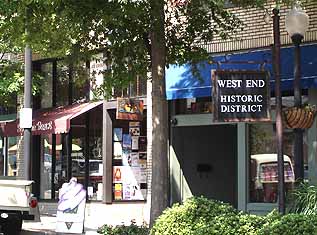 |
One landmark that you simply should not miss is the Joe Jackson statue (above left) a couple of blocks northeast of the ballpark, right next to the West End Market and its shops and galleries. Shoeless Joe grew up in the Greenville area, playing for the very talented mill teams of the region before heading to fame — and eventually shame — on the sport’s grandest stage. The base of the statue is made of bricks salvaged from, appropriately enough, old Comiskey Park (demolished in 1991). Jackson just might be the best player ever to play his home games at old Comiskey.
 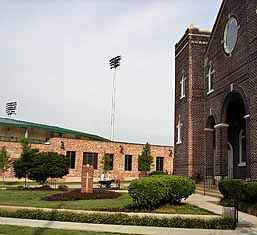 |
In fact, Jackson settled back here after being banished from the game he loved. The house he lived in (above left) was recently moved to a spot directly across the street from the right-field entrance of West End Field. During my visit to Greenville, the interior was still being prepared to make it a full working museum to Shoeless Joe and the history of baseball in the area. What a great idea!
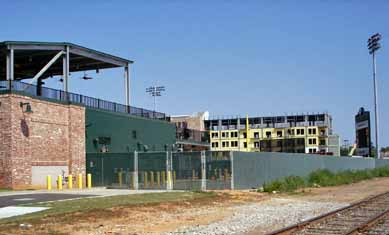 |
Also within a block of the ballpark are old churches, railroad tracks and large, new buildings to hold office space and condos. The scene above shows the view from outside the park near the right-field wall. The condos — still under construction during my visit — can be seen in the center of the shot. Aside from these condos, everything else near West End Field adds to the character of the setting of the park. This area isn’t a contrived old-looking area. It is a beautifully charming, historic area, one definitely worth a visit.
The Exterior
To fit in with its neighborhood of masonry stores and churches, the exterior of West End Field is, naturally, brick. But there’s much more to the story than this. The bricks themselves are not uniform, a fact you wouldn’t really notice unless you paid especially close attention. No, they are a wonderful mixture of different brick types, all with a moderately similar hue. This makes the outside of the park compatible with brick buildings of all types in the immediate area, especially the churches just west of the stadium. Even more interesting is where the bricks came from: like the base of Joe Jackson’s statue, they were salvaged, this time from demolished textile mills in the area. This is beautifully fitting, because the mills were everything in the early days of Greenville, and in fact, Shoeless Joe played his first organized ball with mill teams on the west side of Greenville.
The ballpark structure itself is by no means an imposing, tall edifice. With a field that is well below street level and no seating section with more than 13 rows, the exterior isn’t as tall as most ballparks. That adds to the cozy, intimate feel of the facility.
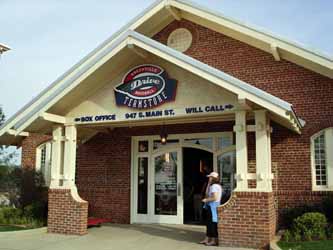  |
There are two main entry points to West End Field, neither of which is behind home plate (although the entrance to the team’s offices is there). One is beyond first base (above right), directly across the street from the transplanted Joe Jackson house. The other, where the main ticket windows are located, is near the left-field foul pole. The latter entrance features a free-standing building (above left) that contains the main souvenir shop and the ticket windows. Make a point of examining this building, as it is a completely refurbished fire station. It was one of the first firehouses in that part of the state, being constructed approximately 80 years ago.
The Design
DLR, the architects for this project, did a very nice job on West End Field, particularly in the way it fits in its fairly limited parcel of land and its Fenway feel.
First, let’s look at the overall “footprint” of the structure. With railroad tracks at one end and irregularly shaped streets at the other, I’m sure the architects spent some time scratching their heads before they first put pencil to paper. Further, there were plans afoot to construct two additional buildings (the office building and the condos) between the park and South Main Street on the northwest side of the park.
To accommodate the seating capacity desired by the team, I’m sure it was tempting to bunch more seats in the infield, creating additional rows or an upper deck. The designers didn’t go this route, and instead kept the intimacy factor intact by specifying that the field be below street level, and limiting the seating section to a maximum of 13 rows.
It worked, and the intimacy at the park is excellent.
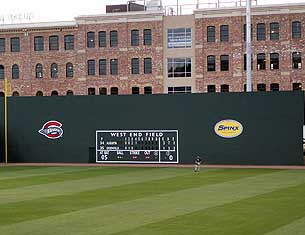 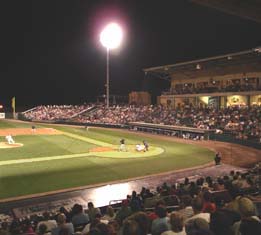 |
As for the “feel” of being at Fenway Park, I’d say that worked, too. Since the Red Sox are the parent team for the Greenville franchise, a conscious decision was made to have the outfield dimensions match Fenway’s exactly, right down to having a Green Monster in left field (above left), although it is only 30 feet tall, instead of the 37 feet of the original in Beantown.
As Drive president Craig Brown told Baseball America, ” … what better idea than to take Fenway Park and accentuate our Red Sox tie and create some more local interest. I mean, the Green Monster in Greenville? It all kind of ties together.”
When I asked Eric Jarinko, the Drive’s Director of Media Relations, what element of the park he felt turned out the best, he didn’t hesitate in saying, “The whole Fenway feel. The Red Sox have such a huge following here that this was important, and it turned out really well.”
The structure has two levels in the infield, as do a lot of newer Minor League parks. The upper level holds the press box, which is behind home plate of course, and then a series of luxury suites — 18 in all — on each side. There is no general seating on this level. Again, this adds to the intimacy.
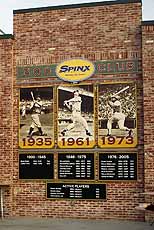 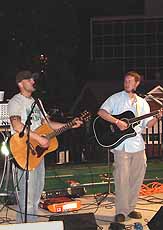 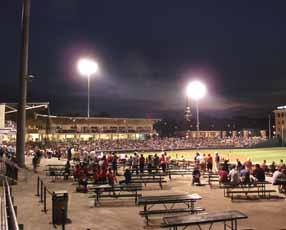 |
Down the first-base line is an interesting area called the 500 Club (above left and center), named to honor the sluggers who have topped 500 homers — most of whom, thankfully, accomplished this without the use of steroids. Up a few steps from the main concourse, this large covered area features a bar, a stage area for live music and lots of tables to sit around. Speaking of tables, the concourses were designed with lots of wide areas for picnic tables and standing around socializing. One more nice design element in a well-designed ballpark.
And a word about the playing field … just like at Fenway, it is in exceptional shape. And just like the surface at Fenway that was completely re-done in 2004, Greenville’s field and drainage system were designed and installed by a team led by Roger Bossard, the same sod king who designed the playing fields at ten big-league parks.
The Essentials
So you’ve visited Greenville’s wonderfully charming “historic West End” prior to the game, and you’ve admired the fine exterior and architecture of the city’s new ballpark. But what is it like to attend a home game of the Drive? Let’s take a look.
The West End doesn’t exactly have a surplus of parking lots, so you’ll either need to arrive early and pay $5 to park in one of the small private lots at churches close to the stadium, or (better yet) take advantage of the free parking at County Square, a short walk from the park. For those who’d rather not make that trek up the modest hill on foot, a free shuttle runs fans back and forth.
Just because the parking and shuttle won’t set you back any money, don’t be concerned that the rest of your experience at the park will be expensive. Far from it. The tickets are reasonably priced at $8.00 and $6.50 for reserved seats, and bleachers and general admission are $5.00. As is the case at most Minor League parks these days, there is a grassy berm for those with general-admission tickets — this one in foul territory down the third-base line. Because (a) none of it is in the outfield and (b) it is angled beautifully toward the infield, I found it to offer the best vantage point of any berm in baseball (see photo below right).
The souvenirs, found at two stands and in the attractively renovated fire house just outside the left-field gate, are also reasonably priced. Adult T-shirts start at just $16, and lapel pins (which I collect everywhere I go) were a bargain at $3. My general assessment of the food at the concession stands is that it is good — not great — but the prices are phenomenal. A regular hot dog was only $2.25, a brat $3.50 and a large beer only $3.75 (I’d seen this same size beer cost $8 at Dodger Stadium a few days earlier). Bottled water, at $1.50, was about half the price as at other parks.
So when it comes to the cost of attending a Drive game, I was relieved that ownership didn’t try to recover their large construction investment (which I believe was in the neighborhood of $15 million) with unreasonably high prices of tickets, souvenirs and concessions.
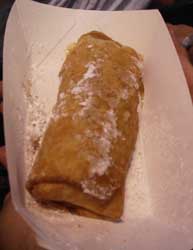 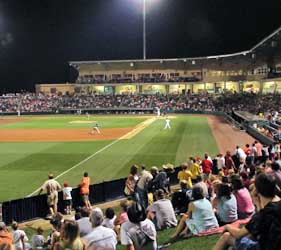 |
There was one food item that definitely deserves mention — although it is not for the calorically challenged. An item called Fried Cheesecake can be found at the Textile Grille stand for $3.50 (see the photo above left). It was incredibly good, even though I felt quite guilty for eating such a decadent delicacy!
In keeping with the Fenway theme, there is a hand-operated scoreboard in the “Green Monster” wall in left field. There is also a stunning video screen above right-center field that was manufactured by the biggest name in such boards, Daktronics.
Your kids will also enjoy themselves at a Drive game, as there is a fair-sized play area down the third-base line (although it can’t hold a candle to the king of all playgrounds at Greensboro’s First Horizon Park, also in the South Atlantic League). They will also appreciate the fact that a Drive player is at the entry gate to greet fans and sign autographs. Reedy Rip-It, an appropriately green-and-fuzzy mascot, is also a hit with the younger set.
There is a tradition at games in Greenville that I really loved. Of course, you’ll hear “Take Me Out To The Ballgame” during the seventh-inning stretch, but in the middle of the eighth, the crowds belts out “Sweet Caroline,” perfect for a gathering of South Carolinians!
All in all, there is a great baseball feel at Drive games. While the on-field, between-inning promotions don’t break any new ground, just being at West End Field feels great. The seats and even the concourses are so close to the field that you are always in the action. Truly, there is a great sense of intimacy, just like at, well, Fenway Park!
Summary
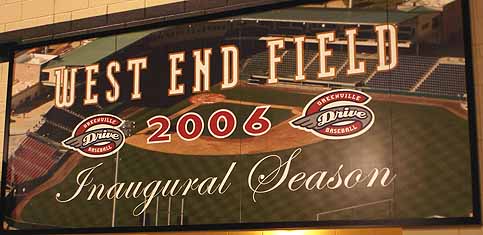 |
In case you’re wondering, the “Drive” nickname for the team wasn’t the result of a “name the team” contest by a newspaper or some online poll. No, the source is a little less dramatic. “Our ad agency came up with it,” Jarinko told me. “At first, the reaction (to the name Drive) was pretty negative, but once people realized what was behind the name, it turned to positive.” If you know much about Greenville, you are probably aware that what was once a mill town is now a thriving city with large plants for BMW and Michelin, as well as a great deal of automotive research and development.
While it’s true that the automotive link was part of the inspiration behind the name Drive, it was by no means the main part. “There is so much drive here from leaders and entrepreneurs, it seemed like a great name,” Jarinko continued. “And people have embraced it, including the logo. Our merchandise sales have been crazy!”
And why not? The fans of Greenville have a city — with all of its charm, history and entrepreneurial drive — and a ballpark to be proud of. In order to be named BASEBALLPARKS.COM’s Ballpark of the Year for 2006 — in a year when the Cardinals opened their huge new playground in St. Louis — West End Field had to be a pretty special place. Indeed, the park offers a great time at very affordable prices and some of the intimacy of its big brother, Fenway Park.